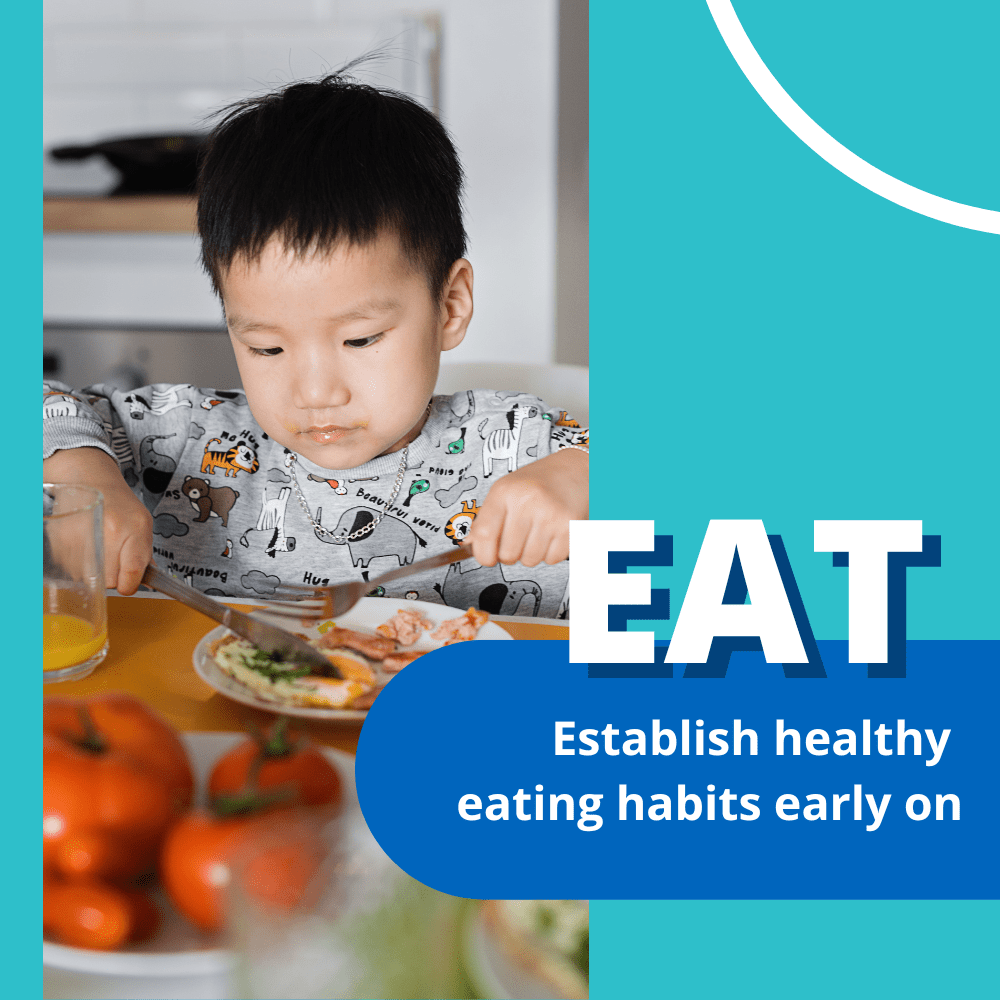How important is it that a child drinks enough water daily, instead of milk, juice, soda, etc.?
LM: Kids should drink water daily to support a healthy and active lifestyle. Water is calorie-free and essential to supporting the body’s vital functions. According to the 2022-2025 Dietary Guidelines, developed by the U.S. Department of Agriculture and U.S. Department of Health and Human Services, beverages with nutrients like milk or 100% juice, can be consumed as part of a healthy diet. For children, it is important to limit sugar-sweetened beverages because they contain “empty” calories, meaning they have calories and sugar but lack the nutrition that the body needs. The Dietary Guidelines recommend limiting added sugars to less than 10% of calories starting at age two.
How can parents help their kids drink more water?
HF: Have a reusable water bottle for each child and help them to keep it filled up throughout the day. Make water the drink of choice at home by not stocking up on sugar-sweetened beverages that may be more tempting to kids.
LM: Infusing water with delicious fruits like berries and citrus adds flavor, making water more delicious and visually appealing for children.
HF: The foods we eat also play a role in being properly hydrated. Raw fruits and vegetables, like cucumbers and watermelon for example, are made up of a high percentage of water. When it's difficult to help children drink enough water throughout the day, incorporating more of these foods can help significantly. If raw fruits and vegetables are a struggle also, try blending them into a smoothie!
How much water should children be drinking per day?
LM: Water recommendations for kids vary based on age and activity level. The American Academy of Pediatrics recommends 5 cups of water a day for kids ages 4 to 8, and 7 to 8 cups per day for older children. For adults, the National Academy of Medicine suggests 13 cups of fluid per day for men and 9 cups per day for women. However, this can vary based on activity level, climate, and pregnancy. Consult with a health professional to help figure out your fluid needs.
How can you tell if your child is not getting enough water?
LM: According to the American Academy of Pediatrics, signs of dehydration for older children can include a dry or sticky mouth and decreased or dark urine output, among other symptoms.
MOVE: Get moving as a family for physical and mental wellness
Expert:
Sarah Kramer, R.N., fitness & intuitive eating coach and Brooks Run Happy Team Ambassador
Parents being active with their kids benefits everyone involved! Getting moving as a family helps children make physical activity a lifelong healthy habit and helps parents stay physically and mentally healthy as well.
“Research shows that when kids engage in physical activity with their parents, they have a much better chance of developing lifelong healthy habits,” says Cami Hawkins, CEO of Marathon Kids. “That’s good news for their bodies and their minds. When children feel healthy, they perform better in school, think more clearly, and can better cope with everyday stress.”
Regular, moderate to vigorous physical activity, such as walking, hiking, riding a bike, playing basketball, or going for a run, isn’t just beneficial for children’s physical health but for their mental health as well. Children who develop the habit of regular physical activity at an early age have lower rates of depression and anxiety compared with their peers who are less active.
According to the US Department of Health and Human Services, children ages 6 to 17 need at least 60 minutes of moderate-to-vigorous physical activity per day. However, only one in five kids in the U.S. currently reaches that minimum.

How can parents get the whole family moving?
SK: One of the best ways to get the whole family active is to be the example. As parents, it’s important to prioritize taking care of ourselves, and engaging in healthy habits makes a difference in our overall well-being. When kids see their parents engaging in running or other forms of physical activity, they will eventually want to mimic that behavior. Over the last 20 years, I’ve been consistently exercising. Our kids have been around mommy during workouts since they were infants, so the exposure has been frequent and repetitive. As they’ve grown, the question is no longer, “Are you going to exercise, Mommy?” Now it’s become, “When are you going to exercise, Mommy?” Kids will start asking to go on walks, bike rides, runs, mimic strength-based exercises, create their own movement sessions and stretch. Eventually they won’t always have to be asked to move their bodies and will come up with the idea on their own. Instead of forcing it to be structured for kids, let them intuitively decide what sounds fun and appeals to them.
Work life balance is hard! How can parents easily incorporate physical activity into their family’s busy daily routine?
SK: This is a struggle for so many people, as they feel varying amounts of stress and responsibilities throughout their days. A big tip is this: know you don’t have to exercise for 30 minutes at a time. Perhaps it’s more accessible if you break it down into three 10-minute sessions. Some days, your day responsibilities may be lighter, and you can fit in a 20-minute workout. The less pressure, guilt, and frustration around exercise, the better. It’s OK if you’re in a season of life where 10 minutes of exercise is your max each day. There will be days when you exceed that or don’t meet it; it’s OK. Stressing out over it does more harm than good, so be gentle with your body and mind. Pick a time of day when you can move your body and not feel so rushed. The time of day you exercise doesn’t matter, so choose what works best for you and your family. Always remember that you deserve to take care of your health too. Everyone benefits!
What are some other physical activities that families can do together for fitness that are also fun?
SK: Kids want to do things that keep their attention, so engaging in sports related activities, letting them choose a route to take for a walk, having a family friendly competition, or emphasizing the positives can make a huge difference. The more you build up the excitement around exercise, the more intrigued kids will be to try. Exercise looks different for everyone, so giving kids the opportunity to try different forms of movement gives them choices and keeps things exciting. Some other great examples are ice skating, roller skating, shooting hoops with a fun game, helping in the garden, mowing the yard, picking up trash in the community, or bowling.
What advice do you have for parents who want to get their kids moving but aren’t necessarily active themselves?
SK: Make exercise fun! The way you speak about exercise is the way kids view it. If it’s about strength, confidence, health, and enjoyment, it feels different. If it’s about being a certain weight or size, the focus is only on external factors and can lead to feelings of shame or guilt. It’s unusual to be great at something the first time you try it. Building up endurance, consistency, strength, and cardio health all take time. If running, it’s also important to know you don’t have to run the entire time you exercise. Take walk breaks by doing intervals, slow your pace, decrease the time, and get your body into the groove of this form of exercise. Be patient and know every time you show up for a run or other physical activity, you’re doing something for yourself.
What are the key success factors for beginners?
SK: As a beginner, you want to start creating a habit around exercise. I tell my coaching clients to start small. This will help you from feeling overwhelmed and allows for behavior change to happen. If you have not been consistently exercising, make your goal one day per week for a structured workout. That may be walking, including shorts bursts of jogging, bodyweight exercises or simply stretching. Don’t overthink it. Focus on moving your body for a specified amount of time, one day per week, and do that for a few weeks. Then, you can add another day of exercise during the week. Continue adding in workouts over a period of time and you’ll find it becomes a habit. When you meet a goal, that gives you momentum to keep moving forward, so that’s why I encourage small goals to start. Achieving small goals will lead to those bigger goals.
How critical of a role does hydration and nutrition play in running and exercise?
SK: Hydration is so important and underrated. Throughout my career as a registered nurse and fitness coach, I’ve seen that most people are underhydrating. Drink more water than you think is necessary. Keep a big container of water with you throughout the day and take frequent sips. If needed, set a timer on your phone to remind you to hydrate. Nutrition is also such an important piece. When you nourish your body well, it responds differently. Knowing you can and should eat a variety of foods each day will keep you satisfied and nourished. What digests well for one person may not digest well for another. Paying attention to your body and the way it responds to food (satiation, digestion, energy levels, hunger cues, physical and mental signs/symptoms) makes such a significant difference. For a long time, the conversation was about eating less, which doesn’t always support what the body needs to thrive. Focus on eating more of the foods that feel good in your body, give you energy, taste good, support overall well-being, and what you can add in versus remove from your lifestyle. Food satisfaction is a must.
Visit MarathonKids.org for more tips, ideas, and free resources to get the whole family moving.

Marathon Kids is a nonprofit on a mission to get kids moving. The organization provides effective physical activity programming to help kids adopt an active lifestyle and learn how being active can improve their entire well-being. Marathon Kids’ program is designed to increase daily physical activity by engaging kids in a positive, goal-driven program that challenges them to run, jog, walk or move over the course of a season.


